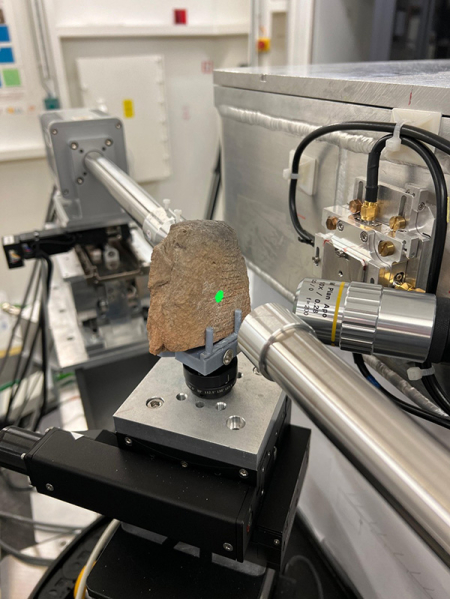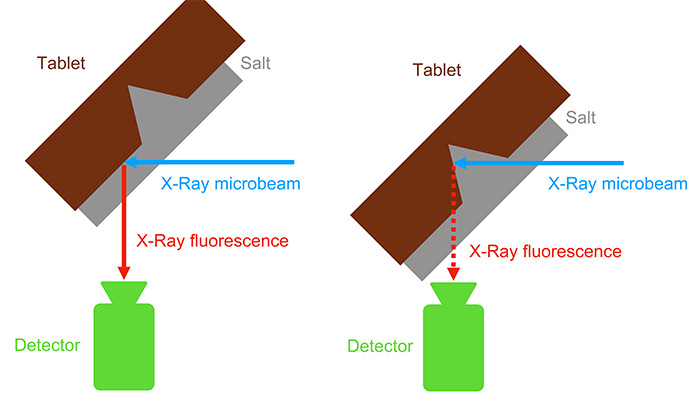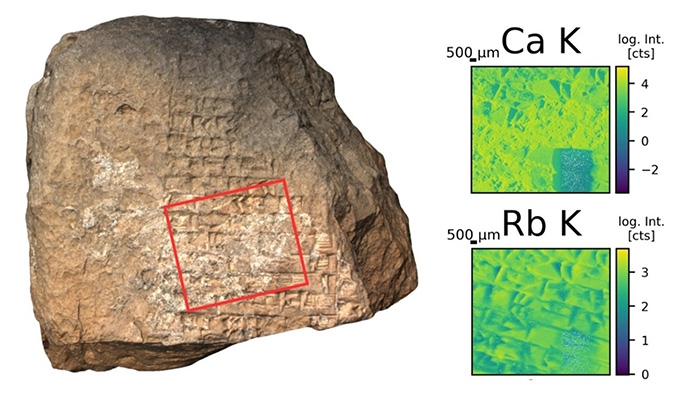Cuneiform tablets are among the oldest written records in human history. Some show salt layers formed after millennia underground, which can crack the clay and completely cover the inscriptions, making them unreadable. Traditional restoration methods often cause irreversible alterations.
Researchers from Ghent University, with support from the IPERION-HS program and in collaboration with the PUMA beamline at SOLEIL Synchrotron, applied X-ray fluorescence spectroscopy, a non-invasive analysis technique, to recover cuneiform signs hidden beneath the salt after millennia.
Salt has long posed a challenge for the study of cuneiform tablets, some of the oldest written artefacts in human history. In most cases, these tablets are made of unfired clay and, after being buried for millennia in the soils of the ancient Near East, they absorbed salts from their environment. When excavated, the salts migrate to the surface, where they crystallise. This causes physical stress, leading to cracks in the clay, and forms encrustations that cover the inscriptions, making them partly or completely illegible. Traditional treatments, such as firing or the use of chemical consolidants, may restore the text but often cause irreversible physicochemical alterations to the clay, including colour changes or the loss of organic traces. A non-invasive approach capable of revealing the hidden text without damaging the artefacts was therefore highly desirable.
To address this issue, a team from Ghent University, including experts in Assyriology and chemistry, applied synchrotron radiation X-ray fluorescence spectroscopy (SR-XRF), a non-invasive technique that uses focused high-energy X-rays to identify the elemental composition of materials. The experiments, which were supported by the EU IPERION-HS program, were carried out at the PUMA beamline of SOLEIL Synchrotron on three cuneiform tablets kept in the Ghent University Museum. These tablets originate from ancient Lower Mesopotamia (modern southern Iraq), date to approximately 2100–2000 BCE (Ur III period), and are visibly covered with salt deposits.

Figure 1: Close view of tablet LW21.CUN.14 (Ghent University Museum) mounted on a polymer holder in the beamline PUMA.
The X-ray beam has been used to excite various trace elements, in particular rubidium, which is naturally present in the clay at concentrations more than 100 times higher than in salt. After excitation by PUMA's X-rays, the Rb atoms fluoresce and re-emit high-energy X-rays, which then penetrate the salt crust covering the clay. And, depending on the relief - clay carved by the writing of a symbol, or “unwritten” clay - the re-emitted X-rays are partially absorbed or not (figure 2).

Figure 2: schematic diagram illustrating the detection of the X-ray fluorescence signal emitted by Rb atoms; left: when the Rb is on an area with no inscription; right: when the Rb is in a hollow of an inscription ; the dotted lines show the attenuation of the fluorescence beam by the clay of the tablet.
This contrast between stronger and weaker fluorescence signals enabled researchers to reconstruct the cuneiform signs under salt layers up to 0.5 mm thick. As a result, entire lines of text, previously unreadable for more than 4,000 years, were made legible again.

Figure 3: XRF cartography of tablet LW21.CUN.14 (Ghent University Museum). Calcium (Ca), concentrated in the surface salts, covers the written text. Rubidium (Rb), present in the clay and absent in the salt, enables to reveal the cuneiform signs beneath.
The contribution of SOLEIL was essential. Conventional lab-based micro-XRF systems do not generate sufficient beam intensity to probe through thick salt layers in a reasonable time. The PUMA beamline provided a stable and intense 20 keV X-ray beam focused to just a few microns, enabling both confocal point analyses and large-area scans efficiently. In parallel, computed tomography scans performed at the Ghent University Centre for Tomography were used to assess the thickness of the salt layers and guide the positioning of the scans.
The application of SR-XRF in this context has opened a new investigative pathway. Future efforts will explore the adaptation of this protocol to laboratory-based XRF instruments, which are more widely available and easier to access than synchrotron facilities. The goal is to develop a method that can approximate the results achieved at SOLEIL while improving accessibility.
To the best of our knowledge, this represents the first application of SR-XRF to ancient artefacts such as cuneiform tablets for the specific purpose of reading inscriptions hidden beneath salt encrustations. While the technique was developed for this case study, it may potentially be extended to other materials and contexts affected by similar preservation issues. However, additional testing is needed to evaluate its applicability on a broader scale.
